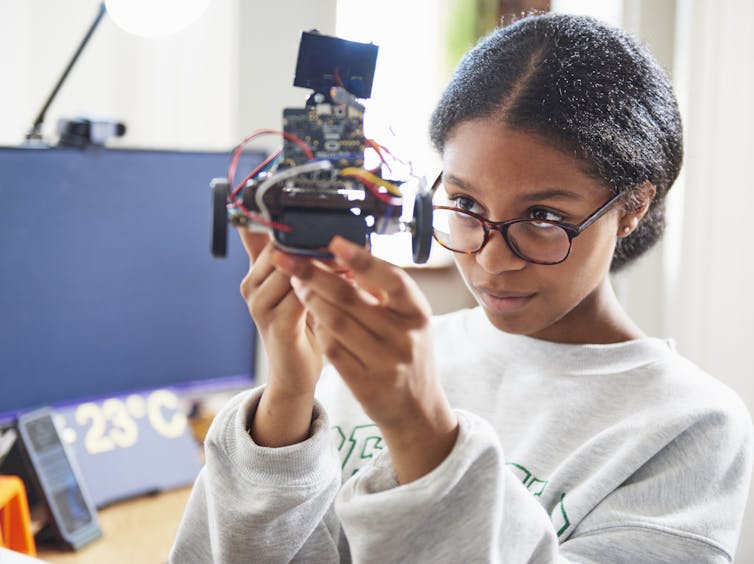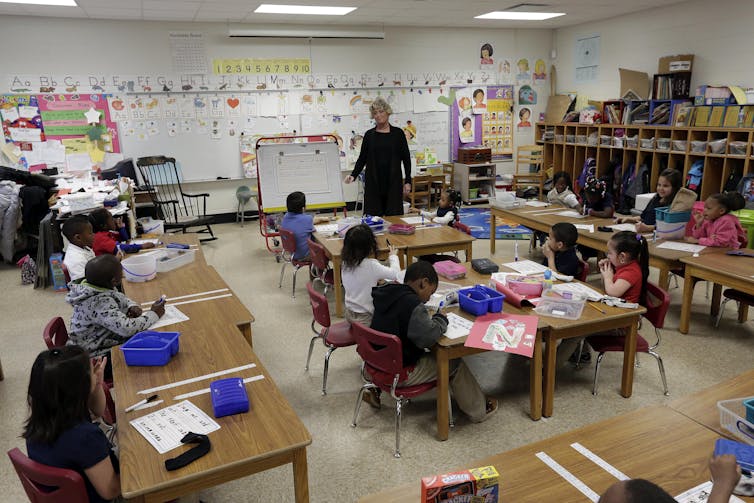
Tara Moore/DigitalVision via Getty Images
Lisa Bosman, Purdue University
Diversifying the science, technology, engineering and math fields has long been a top priority of many universities and tech companies. It’s also a goal of the National Science Foundation, the biggest funder of university-led research and development in the U.S.
But in the field of engineering, at least, there hasn’t been a lot of progress in diversifying the academic pipeline beyond white men.
The share of engineering bachelor’s degrees awarded to Black students has barely budged over the past decade. Women and Hispanic students fared better, but their respective percentages are still well below their shares of the population as a whole. The shares of engineering professors who are Black or Hispanic are also little changed and remain in the low single digits.
Many reasons have been cited for this lack of progress, including stereotypes, lack of exposure, limited role models and the recent backlash against so-called woke policies that emphasize diverse hiring policies. But, as a scholar of STEM education accessibility, I believe there’s another culprit: poorly prepared professors. Unlike the other challenges, it happens to be a much easier problem for universities themselves to remedy.
Some progress – but not a lot
A quick look at the numbers shows there hasn’t been much to show for all the efforts to improve diversity of the engineering field.
For example, in 2011, 4.2% of engineering bachelor’s degrees were awarded to African American students. A decade later, 4.7% of degrees went to African American students.
Progress was better for women and Hispanic students, but the numbers are still far from proportional to demographics. In 2011, Hispanic students earned 8.5% of engineering degrees. That rose to 13.6% in 2021 – versus the group’s 20% share of the U.S. population.
Women similarly saw gains over the years, going from 18% to 24%. But 6 percentage points in 10 years doesn’t look as good when you consider that women make up over half of the population.
The situation is worse when you look at the share who become professors. In 2020, 2.5% of engineering professors were African American, the same share as 10 years earlier. The share of Hispanic engineering professors edged up to 3.9% from 3.7%.
Women fared slightly better, rising to 18.6% from 13.8%, but as noted, that’s still a pretty poor result from all those efforts to diversity the academy.
More broadly, there’s a deeper problem in engineering schools. Just 56% of engineering students complete their bachelor’s degree in six years, according to a 2021 report by the American Society for Engineering Education. That compares with 64% for all fields. A National Science Foundation survey from the same year found that only 65% of science and engineering college graduates were working in a field related to their degree.
In other words, roughly a third of engineering students aren’t getting their degrees, and among those who do, around a third are switching careers – despite investing a lot of money on their education. While there’s limited data available on women or specific racial groups, I don’t think I’m going out on a limb to argue that the numbers for them look even worse.
Engineering teachers lack much teacher training
Among the reasons cited for this, I believe that the roles of teaching and learning haven’t received enough attention.
A growing body of research suggests that the quality of teaching needs to improve to reverse trends of lower graduation rates and properly teach an increasingly diverse student body. And I believe this is especially true in STEM disciplines like engineering.
Engineering professors commonly have training in advanced technical areas, but few receive training in teaching and learning. This challenge of poor teaching preparedness is not limited to the engineering discipline, but the consequences are much worse, especially given the push to diversify STEM.
Effective teaching enhances retention and completion rates by promoting better understanding of the material and creating more student involvement in the learning process. When students are actively engaged, supported and motivated to learn, they are more likely to persist and complete their educational goals.
Teacher training for universities is starkly different than K-12 training. Most school districts require that teachers have a four-year bachelor’s degree in teacher education. The focus is less on content and more on implementing effective teaching practices. K-12 training includes lesson planning, differentiated instruction and best practices for classroom management. There is also often a strong emphasis on social, emotional and behavioral well-being.
Although some engineering doctoral students might gain teaching exposure through a graduate teaching assistantship, this experience is commonly limited to grading assignments and rarely includes course design and development.
To teach as a professor in colleges and universities, most accreditation boards simply require a minimum of 18 graduate credits – or about two semesters – in the topic area. Here, the focus is strictly on research content. No prior teaching experience or training is required.
As a result, newly minted doctoral graduates are thrown into the lion’s den of teaching unprepared. If they are lucky, they are provided with the latest available syllabus. However, new professors are typically unprepared to accommodate students with disabilities, teach Black and Hispanic students, work with remedial students or navigate sensitive topics. They are generally anxious about teaching.
The field of K-12 teacher education has strategies to deal with these challenges. Continuing education and ongoing professional development keep both experienced and inexperienced teachers up to date on inclusive teaching practices. These can include sharing gender pronouns, ensuring media is accessible, using inclusive language and offering diverse perspectives in teaching resources. And yet, keeping up with these changes can be daunting for new professors.

AP Photo/AJ Mast
Teaching teachers to teach
But there is a solution: treating college-level teaching as a professional development opportunity.
Most colleges and universities offer professional development training for professors and other instructors who want to opt in to teacher training, but the programs often have limited scope and responsibility at a level to make a substantial positive impact on student learning and engagement.
One way to change this is to invest in Scholarship of Teaching and Learning programs. This is a scholarly approach in which educators systematically study their teaching practices, student learning outcomes and the effectiveness of various teaching methods and strategies.
At Purdue University, we created a Scholarship of Teaching and Learning Accelerator program to help engineering graduate students around the world improve their teaching methods and share what they learned with others. In 2024, we published a peer-reviewed article that reports the process and what we learned.
By providing comprehensive professional development opportunities tailored to the needs of engineering instructors, institutions can support their ongoing growth and development as effective educators, ultimately enhancing the quality of engineering education and preparing students for success in their future career.
And in turn, better-trained teachers will be better equipped to support students from diverse backgrounds and help those traditionally underrepresented in STEM.
Lisa Bosman, Associate Professor of Industrial Engineering, Purdue University
This article is republished from The Conversation under a Creative Commons license. Read the original article.































































